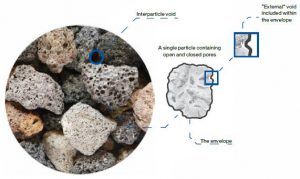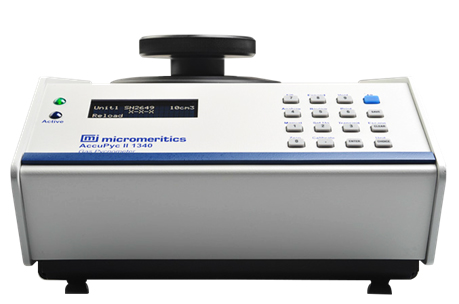AccuPyc II 1340 Pycnometer
Gas Displacement Pycnometry System
Gas pycnometry is recognized as one of the most reliable techniques for obtaining true, absolute, skeletal, and apparent volume and density. This technique is non-destructive as it uses the gas displacement method to measure volume. Inert gases, such as helium or nitrogen, are used as the displacement medium. Density calculations using the gas displacement method are much more accurate and reproducible than the traditional Archimedes water displacement method.
The AccuPyc II 1340 Series Pycnometers are fast, fully automatic pycnometers that provide high-speed, high-precision volume measurements and true density calculations on a wide variety of powders, solids, and slurries. The instrument completes most sample analyses in less than three minutes without sacrificing accuracy. After analyses are started with a few keystrokes, data are collected, calculations are performed, and results displayed. A minimal amount of operator attention is required.

Maintain product integrity with this non-destructive test |
|
|

Maximize your investment-Adaptive configuration to meet your sample size needs |
|
|

Speed of analysis, accuracy, repeatability, and reproducibility |
|
|
Principle of Operation
This technique uses the gas displacement method to measure volume accurately. Inert gases, such as helium or nitrogen, are used as the displacement medium. The sample is sealed in the instrument compartment of known volume,the appropriate inert gas is admitted, and then expanded into another precision internal volume. The pressures observed upon filling
the sample chamber and then discharging it into a second empty chamber allow computation of the sample solid phase volume. Helium molecules rapidly fill pores as small as one angstrom in diameter; only the solid phase of the sample displaces the gas. Dividing this volume into the sample weight gives the gas displacement density.
Total
On an elementary level, the volume of a solid material can be calculated by measuring its length, width, and thickness. However, many materials have within their structure surface irregularities, small fractures, fissures, and pores. Some of these voids or pores are open to the surface or closed within the structure of the solid material. Therefore, differences in the material volume depend on the measurement technique, measurement method, and the conditions under which the measurements were performed.

| Density Type | Definition | Material Volume | Open-PoreVolume | Closed-PoreVolume | Inter particle Volume | External Void Volume | Addressed by |
| True (Absolute) | The mass of a substance divided by its volume, excluding open and closed (or blind) pores |  |
AccuPyc II | ||||
| Skeletal(Apparent) | The ratio of the mass of the solid material to the sum of the volume including closed (or blind) pores |  |
 |
AccuPyc II | |||
| Envelope | The ratio of the mass of a substance to the envelope volume (imaginary boundary surrounding the particle) |  |
 |
 |
 |
 |
GeoPyc |
| Bulk | Mass of the material divided by the volume occupied that includes interstitial space |  |
 |
 |
 |
GeoPyc | |
| TAP | Apparent powder density obtained under stated conditions of tapping |  |
 |
 |
 |
GeoPyc with T.A.P. function |













